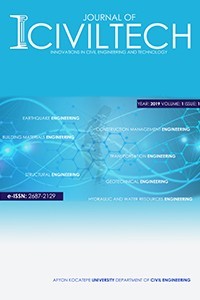Alüminyum Oksit ve Silikon Dioksit ile Modifiye Edilmiş Bitümün Rijitlik Modülünün Ampirik Yöntemle İncelenmesi
Bu çalışmada, bitüm ile alüminyum oksit ve silikon dioksit yüksek devirli karıştırıcı yardımıyla karıştırılarak modifikasyon sağlanmıştır. Bu modifikasyonun sonucunda bitüm performansı standart bitüm deneyleri ile incelenmiştir. Ayrıca ampirik yöntemler kullanılarak rijitlik modülü hesaplanmıştır. Günümüzde nanotüp modifikasyonu yaygın olarak kullanılan bir metot haline gelmiştir. Nanotüplerin yüksek yüzey alanına sahip olmasından dolayı nano boyutta bitüm performansının iyileştirildiği bilinmektedir. Bitüm modifikasyonu ağırlıkça %3, %5 alüminyum oksit ve %0.3 ve %0.5 oranlarında silikon dioksit ile modifiye edilmiştir çünkü silikon dioksitin yüzey alanı ve özgül ağırlığı fazladır. Bitüm karakteristikleri bitüm testleri (dönel viskozimetre, penetrasyon, yumuşama noktası, düktilite, elastik geri dönme ve penetrasyon indeksi) ile belirlenmiştir. Çalışmada bitüm performans derecelendirme (Performance Grade – PG) sistemine göre sınıflandırılmış ve PG 64-22 olarak kullanılmıştır. Ayrıca ampirik yöntemle rijitlik modülü hesaplanmıştır. Sonuçta, 3% Al2O3 ve 0.3% SiO2 modifiye edilmiş bitüm diğer modifikasyonlara göre daha iyi sonuç vermiştir.
Anahtar Kelimeler:
Ampirik modelleme, Rijitlik modülü, Plastik rijitlik, Bitüm performansı, Nanotüp modifikasyonu
Investigating Aluminum Oxide and Silicon Dioxide Modified Bitumen Stiffness Modulus with Empirical Method
In this study, bitumen was modified with aluminum oxide and silicon dioxide using high shear mixer. As a result of this modification, bitumen performance was investigated with standard test methods. Besides, stiffness modulus and plastic stiffness of bitumen was calculated using empirical methods. Nowadays, nanotubes were used for modification of bitumen, commonly. It is known that, nanotubes can improve the bitumen performance at nano level because of having high specific surface area. Bitumen modification was conducted with aluminum oxide at 3%, 5% and silicon dioxide at 0.3%, 0.5% by weight of bitumen because silicon dioxide has high specific surface area and specific gravity. Bitumen characteristics were determined by bitumen tests (rotational viscometer, penetration, softening point, ductility, elastic recovery and penetration index). In this study, bitumen performance grading (PG) system was used and bitumen was used as PG 64-22. In addition, stiffness modulus and plastic stiffness of bitumen was calculated with empirical methods. As a result, 3% Al2O3 and 0.3% SiO2 modified bitumen has the best performance according to the modification and base bitumen.
Keywords:
Empirical modeling, Stiffness modulus, Plastic stiffness, Bitumen performance, Nanotube modification,
___
- Ali S. I. A., Ismail A., Yusoff N. I. M., Hassan N. A., & Ibrahim A. N. H. (2016). Characterization of the performance of aluminum oxide nanoparticles modified asphalt binder, Jurnal Teknologi, 78(4), 91-96.
- Arabani M., & Faramarzi M. (2015). Characterization of CNTs-modified HMA’s mechanical properties, Construction and Building Materials, 83, 207-215.
- Galooyak S. S., Palassi M., Farahani H. Z., & Goli A. (2015). Effect of carbon nanotube on the rheological properties of bitumen, Petroleum and Coal, 57(5), 556-564.
- Hong-liang Z., Man-man S., Shi-feng Z., Yong-ping Z., & Zeng-ping Z. (2016). High and low temperature properties of nano-particles/polymer modified asphalt. Construction and Building Materials, 114, 323-332.
- Karahancer S., Eriskin E., Saltan M., Terzi S., Akbas M. Y., & Cengizhan A. (2019). Moisture Susceptibility of Nano-Al2O3 and SiO2 Modified Asphalt Mixtures. International Airfield and Highway Pavements Conference 2019, 127-135.
- Kuloglu N. (2001). Parameters effects the stiffness of bitumen and hot mix asphalt, Turkish Journal of Engineering and Environmental Science, 25, 61-67.
- Nejad F. M., Nazari H., Naderi K., Khosroshahi F. K., & Oskuei M. H. (2017). Thermal and rheological properties of nanoparticle modified asphalt binder at low and intermediate temperature range, Petroleum Science and Technology, 35(7), 641-646.
- Sadeghnejad M., & Shafabakhsh G. (2017). Use of nano SiO2 and nano TiO2 to improve the mechanical behaviour of stone mastic asphalt mixtures, Construction and Building Materials, 157, 965-974.
- Santagata E., Baglieri O., Tsantilis L., & Dalmazzo D. (2012). Rheological Characterization of Bituminous Binders Modified with Carbon Nanotubes, Procedia-Social and Behavioral Sciences, 53, 546-555.
- Shafabaksh G. H., & Ani O. J. (2015). Experimental investigation of effect of nano TiO2/SiO2 modified bitumen on the rutting and fatigue performance of asphalt mixtures containing steel slag aggregates, Construction and Building Materials, 98, 692-702.
- Ullidtz P., & Larsen B. K. (1984). Mathematical model for predicting pavement performance, Transportation Research Record, 45–54.
- Zhu C., Zhang H., Shi C., & Li S. (2017). Effect of nano-zinc oxide and organic expanded vermiculite on rheological properties of different bitumens before and after aging, Construction and Building Materials, 146, 30-37.
- Yayın Aralığı: 2
- Başlangıç: 2019
- Yayıncı: HÜSEYİN AKBULUT
